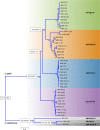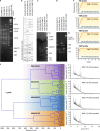Cryptococcus gattii infections
- PMID: 25278580
- PMCID: PMC4187630
- DOI: 10.1128/CMR.00126-13
Cryptococcus gattii infections
Abstract
Understanding of the taxonomy and phylogeny of Cryptococcus gattii has been advanced by modern molecular techniques. C. gattii probably diverged from Cryptococcus neoformans between 16 million and 160 million years ago, depending on the dating methods applied, and maintains diversity by recombining in nature. South America is the likely source of the virulent C. gattii VGII molecular types that have emerged in North America. C. gattii shares major virulence determinants with C. neoformans, although genomic and transcriptomic studies revealed that despite similar genomes, the VGIIa and VGIIb subtypes employ very different transcriptional circuits and manifest differences in virulence phenotypes. Preliminary evidence suggests that C. gattii VGII causes severe lung disease and death without dissemination, whereas C. neoformans disseminates readily to the central nervous system (CNS) and causes death from meningoencephalitis. Overall, currently available data indicate that the C. gattii VGI, VGII, and VGIII molecular types more commonly affect nonimmunocompromised hosts, in contrast to VGIV. New, rapid, cheap diagnostic tests and imaging modalities are assisting early diagnosis and enabling better outcomes of cerebral cryptococcosis. Complications of CNS infection include increased intracranial pressure, severe neurological sequelae, and development of immune reconstitution syndrome, although the mortality rate is low. C. gattii VGII isolates may exhibit higher fluconazole MICs than other genotypes. Optimal therapeutic regimens are yet to be determined; in most cases, initial therapy with amphotericin B and 5-flucytosine is recommended.
Copyright © 2014, American Society for Microbiology. All Rights Reserved.
Figures










References
-
- Kwon-Chung KJ, Bennett JE, Theodore TS. 1978. Cryptococcus bacillisporus sp. nov.: serotype B-C of Cryptococcus neoformans. Int. J. Syst. Bacteriol. 28:616–620. 10.1099/00207713-28-4-616 - DOI
-
- Sanfelice F. 1895. Ueber einen neuen pathogenen Blastomyceten welcher innerhalb der Gewebe unter Bildung kalkartig aussehender Massen degeneriert. Zentralbl. Bakteriol. Parasit. Infect. Hyg. 18:521–526
Publication types
MeSH terms
LinkOut - more resources
Full Text Sources
Other Literature Sources

